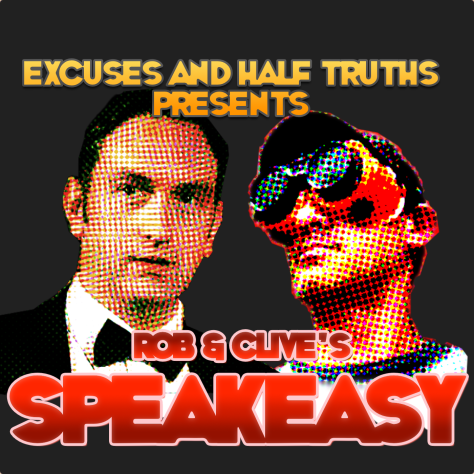Rob Wickings's Blog, page 58
May 19, 2014
Fodderblog: Seven Wonders
We could spend hours discussing the seven wonders of the modern world. The Burj Khalifa Tower in Abu Dhabi, up which Tom Cruise so famously glove-walked. The Øresund Bridge connecting Sweden to Denmark, home of so many angst-driven murders.
But we foodies have our places of worship, too: those parts of the globe where grub is god, where our senses and greedy tums can be fulfilled. These are the culinary Seven Wonders of the world… as least, as far as I'm concerned.
Sukiyobashi Jiro, Tokyo, Japan.
Perhaps the most famous sushi joint in the world, and rightly so. When President Obama visited Japan recently, he made darn sure that he stopped off at Jiro's for lunch. Looking at the place, you might wonder why. It's a tiny box in the basement of an office building in the Ginza district, with room for perhaps ten diners at a time. Jiro serves one menu, and offers only beer or sake to drink. If you can get a reservation to Jiro's (and it's not easy–the booking office is currently closed until June) you're there to eat sushi.
The food is prepared and served with an attention to detail that's obsessive even by Japanese standards. Jiro will watch as you eat, the better to guage what to serve you next, and even where on the plate the next piece will sit. You will pay on average £400 for a meal, and there's a good chance you could be in and out in 20 minutes. But this is food with a purity and rigour that's worth making the effort. The award-winning documentary on Jiro and his life will tell you more–like the food, it's a perfectly presented, tasty little jewel.

Loch Fyne Oyster Bar, Loch Fyne, Scotland.
Not, I hasten to add, anything to do with the ubiquitous seafood restaurants (nice as they are). The tiny, woodlined restaurant on the banks of beautiful Loch Fyne serves a small, perfectly formed menu. But really, you should be going for the oysters. Grown and harvested within yards of your table, Loch Fyne oysters are among the best in the world, and eating them with some good bread (baked on the premises) while gazing out over the loch is a very distinct pleasure. I speak from experience on this one: TLC and I went to Scotland on our honeymoon, and the Loch Fyne Oyster Bar was a very smart stop-off for lunch. A place of peace and beauty, and a very fond memory.
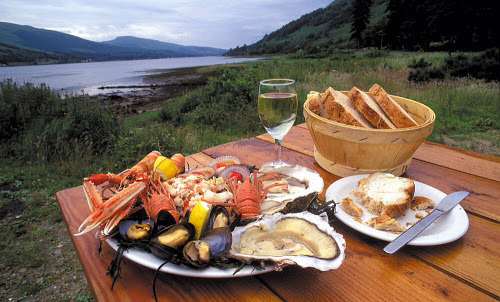
The Cordon Bleu School Of Cookery, Paris, France.
No truly great chef is self-taught, and many of the giants are alumni of the Cordon Bleu. It's an international concern these days, with campuses worldwide. But Paris was the first and, for many, the heart of the French school of cookery that still has such a hold on our preconceptions of culinary excellence.
Let's face it: no chef can consider to have arrived without at least one Michelin star, and that reward comes from cleaving to a model of service and food preparation that springs directly out of the Cordon Bleu. Sure, there are outliers: Jiro's place is Michelin-starred, for example. But for the most part an apparance in the blue book means that a restaurant has achieved a certain level in a certain way. France is, for many, still the home of fine cuisine, and the Cordon Bleu is where you go to learn the skills to make it.
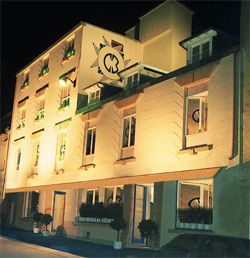
Noma, Copenhagen, Denmark
A list like this would not be complete without including the restaurant that many believe to be the best in the world. That honour can change over time, of course: Heston Blumenthal's Fat Duck is currently closed for refurbishment, Ferran Adria's El Bulli shuttered years ago. Nowadays, the place to be is Denmark, and the place to eat is Noma. Recently returned to the No. 1 spot of Restaurant Magazine's Top 50, Noma is the creative home of chef René Redzepi. His food is deeply connected to the Nordic terroir–that is, the food, ingredients and flavours most typical of the region. Fellow chef Niklas Ekstedt joked recently that you can tell if something's Swedish by the amount of dill on it, but Redzepi's food is far more open to experimentation and adventure than that. There aren't many places that can get away with a dish of beef tartare and ants.
It's said that to get a true feel of a country you need to eat its food. Noma's food is earthy, humorous and full of surprises. If you can get a reservation, and you can afford it (both increasingly unlikely following Noma's return to the top spot, but no harm in trying, eh?) then this is one place to put on your bucket list.
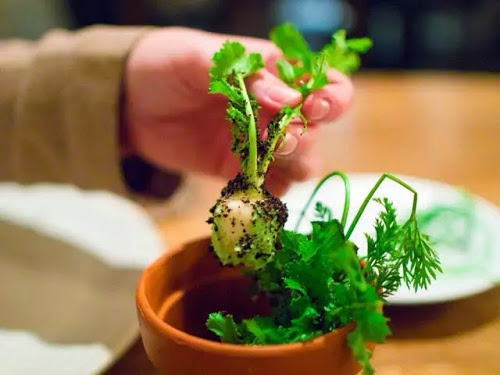
Soi Rumbuttri, Bangkok, Thailand
If your tastes or your bank balance don't run to Noma's level, then there's always street food. Here's where you can get a true sense of a country, with the food that people are lunching, breakfasting or simply snacking on every day of the week. From Mexico to Marrakech, there are plenty of hubs where people gather for their fix of noodles or deep-fried goodies.
The place to be though, at least according to the well-travelled trencherperson, is Bangkok. More precisely, Soi Rumbuttri, a U-shaped street off the Khao San Road (in other words, away from the backpackers) that is home to over a hundred food stalls. Here's where you can track down your food fix from a wild mix of Asian cuisines, prepared on the spot for pennies. OK, you don't get the refinement and service of a place like Noma. But you are getting a jolt of culture and flavour straight off the main grid. The nightlife in this buzzing, active area is amazing too. If you're hungry for the real Thailand, this is where to head.

Queen Victoria Market, Melbourne, Australia
Any foodie worth his or her salt will want to track down a local market. Again, if food is a mirror to a nation's soul, then the raw ingredients that a market supplies are the frame on which that mirror is built. There are a ton of truly great markets for the adventurous food fan to seek out, from London's own Borough Market to La Boqueria in Barcelona–the only place to buy jamon. I'll admit to a soft spot for Oxford's covered market, which has some great food stalls amongst the clothes shops.
But for sheer dizzying size and spectacle, you'll have to take a trip to the antipodes. Queen Vic Market is the largest in the Southern Hemisphere, with over 700 stalls selling… well, you name it. The place takes up two whole city blocks, so if it's food related, you'll probably find what tickles your taste buds. The Meat Hall is the place for curious carnivores, with stalls selling everything from chicken to crocodile. If you're peckish, the Food Court seats 400, so you can probably snag a table. The problem, I feel, is going to be lugging all your goodies home at the end of the day.

Quayside, Whitby, England
We've talked about food reflecting the soul of a country, so let's finish off by bringing it all back home. There's nothing more English than fish and chips, and those in the know agree that the best in the country are found on the north-east coast. Although my mate Rev Sherlock has always bigged up the fish suppers in Grimsby (a little local bias, perhaps: he's from there) the place to be, at least according to the Fish And Chip Awards, is a little way up the coast at Whitby.
Quayside, run by Stuart Fusco since 1999, is housed in a historic building right on the quay. Stuart fries his fish and chips the traditional way: in beef dripping, with a special-recipe batter. There's no better way to enjoy them then out on the quayside, watching the waves. To my mind seafood doesn't get any simpler are more tasty than that.
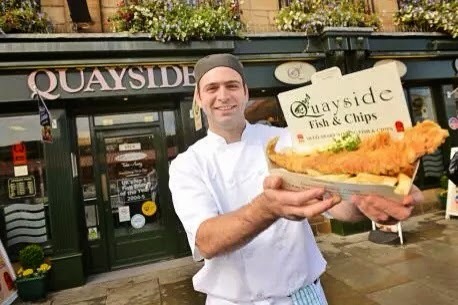
Those are my picks–where have I gone wrong? Hit me up in the comments, Readership!
(a tip of the toque to Edible Reading, who set me on this road in the first place).


May 16, 2014
Goin’ South: BraineHownd Shows Code Grey
It’s been a while since I visited a film night. Nice to get out every once in a while. It’s all Clive’s fault, of course. It usually is.
He was asked by the lovely Mark Brown of BraineHownd Films if he had any content for their new film night in South London. His latest venture, Acceptance, is still in post-production (although I hope to have good news on that soonly) so he decided to dig something out of the archive–our 2009 Straight8 film, Code Grey.
Now, that film has had some traction behind it, winning Best UK Film at the 2009 Cambridge Super 8 Film Festival. But Code Grey, along with my other movies, has slipped into a gentle retirement on YouTube. Could it still stand up in front of a paying audience? Would anyone laugh at the jokes–or at least, at Clive in a policeman’s outfit? There was only one way to find out…
Forest Hill is a pleasant, leafy South London suburb, surprisingly easy to get to from the centre of town: a 15 minute, four-stop train ride. So much for Saarf Lunnun being hard to get around. The Hob, the venue for the evening’s shenanigans, is even more usefully situated– across the road from the train station. Although you do need to know which exit to use, as I discovered to my cost. 20 minutes of wandering around on the wrong side of the tracks is, apparently, something of a rite of passage for first-timers to The Hob.
I was greeted, once I finally found my way through the doors of The Hob, by a large, friendly room and Clive with a very welcome pint. The Hob is a hub (see what I did there) for stand-up comedy, with a stage downstairs and a full room upstairs. This makes it much more easily set up as a venue for films: for one thing, there’s a proper screen. The Hideaway Bar in Crouch End, BraineHownd’s former home, had a decent sized room but a sheet for a screen. No need for that.
 Mike Shepherd, rocking the mic right.
Mike Shepherd, rocking the mic right.Comedian and History’s Greatest Monster Mike Shepherd expertly guided us through the evening. There was a cornucopia of goodies.
Sam Toller and Josh Barnett’s Get Your Slice is both satire and promo on the small arts festival scene, and made one point very clear–if you’re going to start a festival, there has to be cake. Phil Haine and Jonathan Brown’s I Am Lonely is a clever slice of zomb-com which gives new proof to Sartre’s assertation that hell is other people. Touched by Jeremiah Quinn is a mood piece on grieving and letting go: beautifully shot if a little dour. There was a promo for in-production feature Cattle Raid, a futuristic take on an old Irish myth, and Fluffy: A Love Story, a clever and screamingly funny short on the way we can sublimate our feelings into the smallest and most inconsequential of objects.
Oh yes, and there was Code Grey. I’m glad to report that it still works, and trust me, there’s no buzz like writing a comedy and getting laughs out of an audience in the places you planned. With a surprise appearance from other cast member Andrew Lawden, we rocked the Q&A.
With that lot, a presentation from arts crowdfunding startup Phundee, and a chance to chat to some old friends (Hi, Lou!) the BraineHownd night was packed full of film-makey goodness. I was sorry to have to slope off to catch my last train, but the effort in getting out to South London was well worth it. On the opening night of the Cannes Film Festival, Forest Hill was the place to be. I left re-energised, and the long trip back home gave me enough time to blast out a script for a new collaboration that the Leading Man and I are working on. More news on that through the next few months.
Thanks again to the guys at Brainehownd for letting us show Code Grey. They run regular evenings both at The Hob and Crouch End’s Art House Cinema. For more info, check out the Facebookery.
And while we’re at it, here’s the film all the fuss was about, with apologies to Andrew and Fiona, who have had to suffer misspellings on credits for the last five years. Finally fixed…


May 12, 2014
Excuses And Half Truths Presents: Rob & Clive’s Speakeasy!
All new, kind of different: Excuses And Half Truths Presents Rob & Clive’s Speakeasy!
Live from our new studio in London’s trendy Clerkenwell, The Speakeasy hits its first anniversary with a fresh coat of paint and a shoeshine.
Joining our intrepid podcastanauts on this new and exciting stage in our sonic journey are long time friend of the Speakeasy Simon Aitken, and first-timer Maria Thomas. Together, they share their hopes on the upcoming summer season at the movies, and give us their picks of the films to look out for over the next few months.
Hope you enjoy our new direction.


May 9, 2014
Loops And Tones: The Delian Mode
For a generation of British kids, the notion of something being scary was irrevocably tied up with the notion of the otherworldly sounds coming from the mind of sonic pioneer Delia Derbyshire.
Doco Dom was at a recent event at the Cube Microplex in Bristol that celebrated her life and work.
She's best known for co-creating the Doctor Who theme in collaboration with composer Ron Grainer. Her rendition of Grainer's tune, painstakingly created through the use of tape loops and treated manipulations of a single plucked wire, is instantly recognisable. It still sends a shiver down the spines of kids brought up in the 60s and early seventies. When he first heard what Derbyshire had done, Grainer reportedly exclaimed “Did I write that?” Delia's calm response? “Most of it.” But there's more to Derbyshire than that one piece, however iconic it might be. Her work spanned decades, genres and broadcast formats, bringing the notion of electronic music to the living rooms of millions of people.
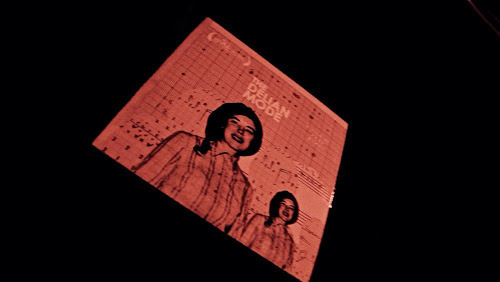
The event at the Cube featured live performances insired by Delia, and a screening of Kara Blake's 2009 documentary, The Delian Mode. This short film takes an impressionistic and appropriately trippy flip through Derbyshire's musical journey, from her childhood in bomb-strafed Coventry (she cites the sound of air-raid sirens as an early influence) to her ground-breaking time at Cambridge as one of the few women reading mathematics, to her time at the BBC's revolutionary Radiophonic Workshop. It deals with the lows (Derbyshire's depression and alcoholism) as well as the highs, and makes one thing very clear–she was a true innovator.
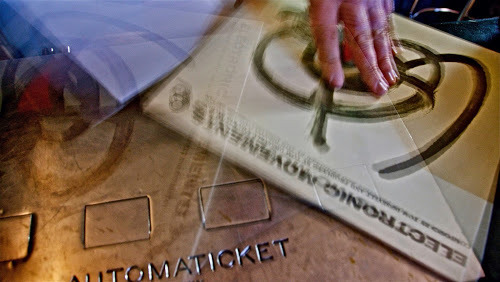
Her musical influence reaches far and wide, as interviews with Portishead's Adrian Utley, Pete Kimber AKA Sonic Boom and Ann Shenton from Add N To (X) make plain. Her status as a pioneer of electronic music has never been more prelavent in both today's chart music and its production: Delia's grid-based method of plotting her music looks to me like an early paper version of the kind of sequencer software that's easily downloadable to the iPad today.

In a world where hauntology's spooky soundtracks and the retro eerieness of Richard Littler's Scarfolk are part of the cultural landscape, Delia Derbyshire has never been more of the moment. She was always ahead of her time. Frankly, I think that time has come. This is Delia's world. We're just living in it.
Photos by Dominic Wade, taken during the Delia Derbyshire evening at the Cube Microplex in Bristol, April 26th 2014.
For more on the Delian Mode, including viewing and purchse information, visit http://thedelianmode.com
For more on the Delia Derbyshire Day event, visit http://deliaderbyshireday.wordpress.com/delia-darlings-on-tour/


May 6, 2014
Rob’s Springtime Chicken
I've spent two bank holidays in a row in the garden. Sunshine and exercise had brought on the need to eat light, fresh flavours–but I'm not in the mood for a salad quite yet.
It's silly not to embrace the best of the season, though. English asparagus, the best in the world, and the first new potatoes will make for a great forkful. Some fish on the side? Maybe, but like I say, I've been busy in the garden. Man need meat.
Of course, the sun has also kicked the herb garden into high gear, which means it's time to start making my favourite green sauce–one that would make a fantastic marinade for the chicken thighs that just happen to be left over from feeding the weekend's workforce. I think we have a plan for dinner.
Start with the sauce. You want a honking great double handful of soft greenery. I have mint, parsley, fennel, and lovage (a celery-like leaf that's great in stocks, stews or anywhere you'd add celery) but you can add whatever's to hand. Basil's great in this, especially if you can snag a bunch of the big Meditteranean stuff. Stuff the whole lot in a food processor and start your engines. Once blitzing, pour in enough oil to form an emulsion–you're probably looking at 100ml or so, but again, don't stint. Think American bartender with yur wrist action. You want this sloppy. Plain olive oil is fine, although I've transitioned onto English rapeseed oil, which is just as good and doesn't have the air miles attached.
You'll probably want to scrape down the sides of your bowl now, then add the juice of a lemon and a palmful of capers, complete with either the brine or salt they came in. Blitz again. Now taste. You want a bright, zingy, herby flavour. At this stage, it'll probably need something. Probably a little more salt or lemon. You'll know when you've hit the sweet spot–it'll taste like someone's popped off a herb bomb in your mouth.
Once you're happy with the sauce, bung about half into a ziploc bag, add your chicken, seal, smoosh everything about and stick it in the fridge for a bit. A couple of hours is prime, but if you only have a half hour, so be it.
Now to the veg. Get a pan of water onto boil, and set up a steamer over the top. Add the spuds once you have a rolling bubble, give them ten minutes or so, then pop the asparagus into the steamer and let that cook through as the potatoes finish off. Another ten minutes. No more than that for the asparagus.
As you're boiling the water for the spuds, get a pan hot for the chicken. A ridged griddle is ideal for this. It'll be ready to go by the time you pop the asparagus on. Whack the chicken, complete with marinade, onto the hot grill. Five minutes a side, maybe a little longer if you're using thick chunks of breast meat. Boneless thighs won't take as long, and the extra fat content means they crisp up beautifully.
Now, if the god of timing has been kind, everything will be ready to plate at once. The veg should yield tenderly to the point of a knife and the chicken will be cooked through and have sizzling griddle lines scored on it. That's all the work done. Plate up and fill your face.
On the side, why not have a dollop more of the green sauce, perhaps mixed into a little yoghurt? It gives a fresher taste than your traditional hollandaise. Perhaps some aioli would be good.
You can tweak this, of course. I'm considering an Asian version with coriander instead of parsley (yes, I know I've said I don't like the stuff but it can work in the right setting) and lime juice in the sauce (perhaps a chilli and a shallot as well), with pak choi and noodles on the side. I may throw some toasted pine nuts into the leftover sauce, and slop the lot over some linguini for an emergency midweek dinner. Oh, and of course the green sauce will also work with fish, pork, a lamb chop, even a minute steak.
I have a lot of herbs in my garden. I need to make this stuff weekly to stop us from getting lost in the jungle.


April 29, 2014
Better Than TV: Neil Finn at Colston Hall, Bristol
There are some artists for which you just always have to make time.
For TLC and I, there can never be an excuse. If Neil Finn's in town, we'll be there.
Whether as part of Crowded House, with his brother Tim or, as on this tour, solo, there's something about a Finn gig. A sense of belonging, of family. Comfort in the simple things. All of which are, of course, primary concerns for mister Finn himself.
Bristol has become as viable a trip to see a gig as London for us these days. 90 minutes up the M4 means that the airy, modern Colston Hall is easily within reach for us. Who needs the Smoke when you can have the sea? After a gentle afternoon with Doco Dom and Lady Dem in their new pied à terre in Fishponds, we drifted to our seats and whooped as the lights went down and a vast coral-cloud spiral lit up behind the band.
Neil has said that he's touring as himself this go-around in order to explore every aspect of his career. The first three songs of the gig made this clear as day, as he bounced from Impressions (off the new album) to History Never Repeats (from the Split Enz days) to the Crowded House classic Distant Sun. Over the next two and a half hours, he explored every inch of his back pages.
It was, as ever, a joyful, emotional ride. I frequently find myself with tears on my cheeks at a Finn gig. The songs are part of my history, and belting them out at the top of my voice will always bring up a wobble or two. His songs, seeking out the surreal and erotic in the mundane and everyday, have a way of slipping under your skin, nestling close without you even realising. They stay put, welcome lodgers in the box room in your head. As the saying goes, you know more Neil Finn songs than you think you do.
On a rainy, dull evening in Bristol, Neil Finn set us aglow. His band, including wife Sharon on Hofner bass (I have an extremely libellous theory as to why she's taken to accompying him on tour–buy me a beer and I'll share it with you) were on the top of their game. He's clearly proud of the young ensemble, shouting them out at the head of the gig. Guitarist Jesse Sheehan and vocalist Lisa Tomlins added a hint of slinky glamour at the front, but they both had musical chops to spare, adding lush harmonies to Neil's husky tones.
The soulful, funkier edge to the new material has, I'll admit, made the new album Dizzy Heights much more of a slow-grower for me than the average dose of Finn (and I still have to skip the painfully earnest Divebomber) but played live the songs have much more of a bounce and bite to them. It's a sign, I think, of a songwriter that's still prepared to take risks, be playful and allow the songs to change up in front of a live audience. That's something he's always done well: turning Don't Dream It's over into a piano-led track, or dragging a guy from the audience up to play a solo during Take A Walk (nice work, Simon).
We rolled out into a rainy evening, and waited for a taxi under the awning of the Bristol Hippodrome while watching the college girls teeter past on un-necessary heels. As ever, Neil Finn had dropped a hazy shade of springtime onto a miserable English evening, and made it shine.
As Neil saw fit to take a walk through the back catalogue, it would be remiss of me not to do the same. Behold: my Spotify playlist of all things Finn.


April 28, 2014
Pizza Is Like Shakespeare: The Stable, Bristol
Bristol isn't ever going to struggle for good places to eat. From gastro to pub grub, the city is stuffed with nice spaces to tie on a nose-bag. On our visits to the city by the sea, I've always been impressed by the range of fab eateries on offer and their increasing focus on local provenance. One of the best recent examples of that philosophy has been, of all places, a pizza joint.
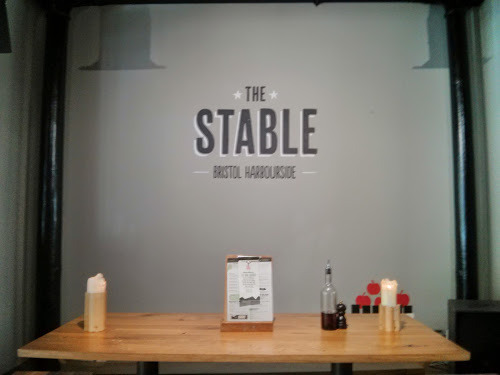
The Stable is part of a small chain of restaurants dotted around the south-west with a pretty unique USP. They've come up with a food and drink pairing that I'd never considered–pizza and cider. After a lunchtime visit, I'm a convert to the cause.
I mentioned provenance, and The Stable is dead serious about sourcing locally. The all-important crust is a sourdough made from organic British wheat. The meat and seafood falls well within locavore metrics, and the huge range of ciders and perries is all from the lower left of the country. They offer drinks by draft, bottle and mini-keg with a limited range of beers and wines and softies. The staff are friendly and knowledgable, affably offering me a couple of tasters to help me make up my mind.
Cider and pizza? Well, yeah, think about it. A beer with your margherita is a big wallop of wheatiness that'll leave you with a fat dose of bloat. Cider doesn't give you that, and you consequently find the food much more digestable. The lighter, crisper flavour just seems to cut through the richness of the toppings with a cleanliness that beer or wine simply can't. It's a deliciously logical pairing.
 Pictured, my Longhorn Jim, approximately 15 seconds after it hit the table.
Pictured, my Longhorn Jim, approximately 15 seconds after it hit the table. The pizzas are thin-crust and loaded with goodies, firing out with admirable speed from a brace of hefty wood-fired ovens. The generosity of the topppings means the most sensible option from getting the pizza into your feed hole is American-style: grab a slice, fold the pointy end over towards the crust and munch away. With my Longhorn Jim, heavy with ground beef, chorizo and ham (I'm a lapsed vegetarian, can you tell?) the crust was just strong enough to take the moisure from the tomato sauce and copious amounts of paprika-spiked oil to make it from wooden paddle to gob. TLC's Avonmouth Angler, though, was so heaped with smoked salmon and mackeral that she had to resort to a knife and fork. Mean while, DocoDom's Portishead Porker was every Englishman's dream: bacon, mushroom, tomato and a fried egg, breakfast on a pizza base.
Already hugely popular of an evening, The Stable seems well on its way to becoming a bit of a Bristol favourite, calmly buzzy at half twelve on a Sunday afternoon. Unflappable service and great grub in a spot that puts you right in the middle of Bristol's shopping and cultural hub? Bit of a no-brainer, frankly. The four of us were more than happy: sipping, nibbling and considering how The Stable were putting a wryly British spin on the Italian classic. Much like Shakespeare, pizza stands up to pretty much any setting into which you care to place it.


April 25, 2014
How We Used To Live
DocoDom and I took a trip to old London Town last week, for a look back into the city's past.
As a birthday treat for the lad, I'd snagged us tickets to a screening to the latest collaboration between film-maker Paul Kelly and retro pop smart-alecks Saint Etienne. How We Used To Live marks a departure for the team, who've made four movies together. This time, rather than using fresh material, the film is built entirely from colour footage of government information shorts made betwen 1950 and 1980.
Voiced with world-weary charm by Ian McShane, How We Used To Live is a plotless piece that's all about invoking a certain mood: an air of nostalgia for a London that is overlaid by the present, but still peeks through the gaps. It's a film that, by the very nature of its central concept, is built in the edit suite. That gives Kelly and his scriptwriters, Bob Stanley and Travis Elborough, a chance to be playful, pitting archival voiceover against mismatching pictures. It's not a new technique, but one that works well when, for example, shots of parliament are intercut with crime narration. This sense of play creeps into the montage as a whole, as Kelly cheekily places shots of city traders against horse racing footage–are the markets just one big gamble?
Against it all, Pete Wiggs places that Saint Etienne sound. Analog synths burble alongside early computer footage, while the pure pop sensibilities that the band is best known for come into play as Sarah Cracknell coos over shots of swinging London.
Like I say, it's a mood piece. There's little sense of any plot or particular narrative thrust. The closest you get is a loose aggregation of theme: London at night; London at work; London at play. Ian McShane growls away over the top, offering one-liners, giving the impression that he's just having a chat in a bar. It's fine as far as it goes, but it's all a bit insubstantial.
The problem for me stems from the choice of limited source material. By only working in colour, from 1950 to 1980, there should still be a ton of film to work with. But as Kelly was only sourcing clips from the BFI library (I have the feeling he was calling in a favour or two) a sense of repetition sneaks in. Without any Pathé or Gaumont newsreel, without any BBC film, I feel that he's just skimming over the surface of what's really available. I applaud the decision to stick to colour–it's a rich, good-looking film with gorgeous poppy reds. But as yet another shot of Piccadilly Circus rolled past, I couldn't help but think that Kelly simply wasn't trying that hard. For a film that was allegedly four years in the making, it all feels a bit slight, cruising on the reputation of the creative team.
How We Used To Live isn't a bad film by any means. It's nice-looking, sweet-natured, a feel-good piece. But it brushes lightly over some themes and ideas that could have given the movie some real bite. The immigrant experience in London, for example, is dealt with in a minute flat–some shots of a dance party, a couple of rude boys are bundled into a police car and oh, look, we're back in Carnaby Street. I was excited to see some Super 8 of the early days of punk, but again it blew by in seconds, contextless, just more pretty pictures.
At 70 minutes How We Used To Live is an easy watch with some interesting and rare footage, but it's so mired in its own sense of nostalgia that it becomes, to my mind at least, the cinematic equivalent of a coffee-table book. Lovely to look at and flick through, but not something you take off the shelf very often. Expect to see it playing in the background of a Hoxton bar this summer.


April 22, 2014
Considerations On Mint Sauce
I decided to go slightly trad for Sunday lunch, and roasted a leg of lamb, stuffed with garlic and rosemary. Slow-cooked, I knew it would be a winner. A leek and potato bake, and some steamed veggies on the side–winner, winner Sunday dinner, right?
“And mint sauce,” Pam-In-Law insisted. “You have to make mint sauce.”
Ah. Right. Here's the thing. Traditional English mint sauce is something I haven't eaten in years, and have never made. I was never really a fan when I was a kid: I was a fairly pernickety eater, and that weird green stuff Dad ladled onto the plate alongside my roast beast was studiously ignored.
The notion of a mint-laden sauce with lamb isn't a dumb idea, of course. Tradition has roots in good sense, especially when it comes to matters of the table. I'd happily serve a dollop of green-flecked yoghurt, or a salsa verde, sharp and salty with capers, lemon and the herbs that are starting to rouse in the garden alongside the lamb. Mint sauce? A new one on me. But I like a challenge, and Pam had done sterling service in the garden over the weekend. The least I could do was give her the Sunday lunch she wanted.
It turns out that mint sauce is a doddle. A big handful of finely chopped mint go into a mix of 150ml of malt vinegar and 50g of demerara. It's made in seconds in a food processor, as long as you give it a little time to let the sugar dissolve. It worked really well with the lamb: sweet-sharp, astringent from the herb, the whole knitting together to cut cleanly through the fattiness of the meat.
What struck me was how Asiatic it tasted. That 3:1 acid to sugar ratio is the starting point to a lot of dipping sauces that would be spot on with sizzling prawn or chicken skewers–a sweet-sharp hit that makes the whole thing dance in your mouth. With that base in place, it's easy-peasy to jazz up the flavours. The trick is to chop anything that you want to put into the sauce as finely as possible.
Here's my take on a thin sauce that would dazzle with any grilled or roast meat, or seafood.
The 3:1 base is of course, a must–the bedrock on which you build everything else. But try a red or white wine vinegar instead of the malt, and honey rather than demerara. The two will blend more easily. A finely minced shallot and clove of garlic add pep and bite, and a fresh chili for a zap of heat. Ginger? Why not?
Then herbs: mint, of course, but why not some basil, parsley, oregano and even dill? Tweak the mix of greenery depending on your tastes and what's available, but make sure not to stint on it. A good big handful, please. You notice I've not mentioned coriander. Not a fan of the leaf, I'm afraid, but you go ahead.
Actually, while we're thinking about it, a little cumin and coriander powder would be nice. And salt and pepper, of course. What was I thinking by missing them out?
My trusty stick blender has a mini-food processor that clips onto the end, which means I can stuff all the ingredients in, give it a blast and hey bingo, sauce is served. For speed, this really needs to go through a blender, but if you have the time and inclination to chop everything by hand, go do it to it. Just make sure the herbs and hard ingredients are really finely chopped. The greens should be no bigger than the contents of a tea bag.
Try this and serve it with the next big roast you make. I think you'll be surprised at how well it works. I plan on giving some to Pam. I hope she'll approve.
ADDENDUM
It appears that the above post is the 1000th to appear on Excuses And Half Truths. That's a whole lot of chat, blather and nonsense. Thanks for sticking with us, Readership.


April 19, 2014
The April Speakeasy: Concept Album Special!
As is appropriate for a podcast about the concept album, BEHOLD our most epic Speakeasy yet. Over two hours of chat as Rob, Clive and special guest writer Stuart Wright discuss that most derided of formats and find a few gems… and yes, a couple of turkeys.
Also, our 50 Second SoundCloud Challenge covers Skweee, Moombahton and other genres you never knew existed!
Download: april-concept.m4a
Here’s the Spotify playlist of the albums we’re discussing:
and the one album not on Spotify: The Lamb Lies Down On Broadway!
and a link to Stu’s site…
Britflicks: Stuart Wright talks film!



